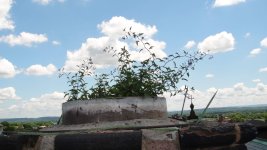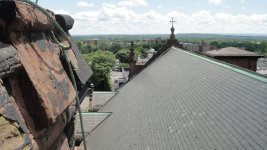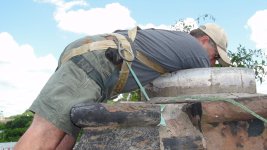JB4310
Super Member
I don't know much about lightning protection but I occasionally find myself repairing components of lightning protection systems on old churches and schools, mostly because no one else wants to or can get to them.
This is a church I've worked on for close to 30 years now, the system is old and often I find wires broken so I splice them where possible. We work across the ridge of the building sometimes and believe me you don't want to sit on one of those 12" high spikes
Pictures;
This chimney is 92 feet high, you can see the old system in place, we use a boom lift, imagine how the old timers got up there!
Plus, Lightning truncated one of these twin steeple towers years ago, unsure whether it was protected or not, but guessing not.
Oh yeah don't forget it was Ben Franklin who gave us lightning protection, probably one of his greatest and most enduring contributions/ inventions, even though not many people even give it a second thought. It's pretty much a world wide standard that we could not live without.
JB.
This is a church I've worked on for close to 30 years now, the system is old and often I find wires broken so I splice them where possible. We work across the ridge of the building sometimes and believe me you don't want to sit on one of those 12" high spikes
Pictures;
This chimney is 92 feet high, you can see the old system in place, we use a boom lift, imagine how the old timers got up there!
Plus, Lightning truncated one of these twin steeple towers years ago, unsure whether it was protected or not, but guessing not.
Oh yeah don't forget it was Ben Franklin who gave us lightning protection, probably one of his greatest and most enduring contributions/ inventions, even though not many people even give it a second thought. It's pretty much a world wide standard that we could not live without.
JB.



